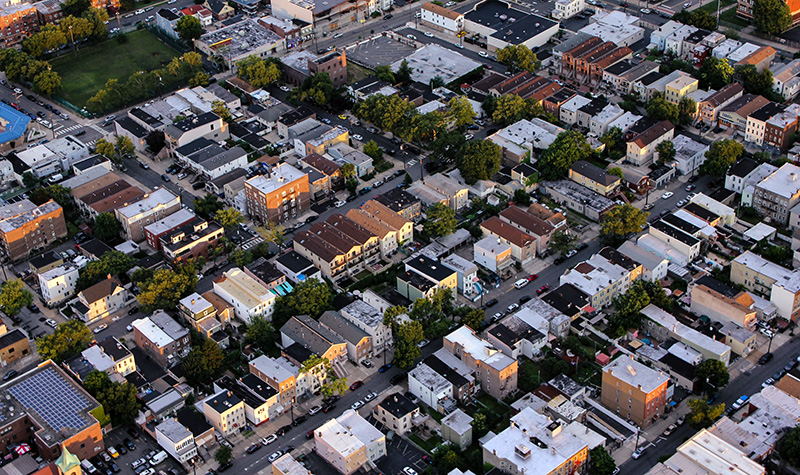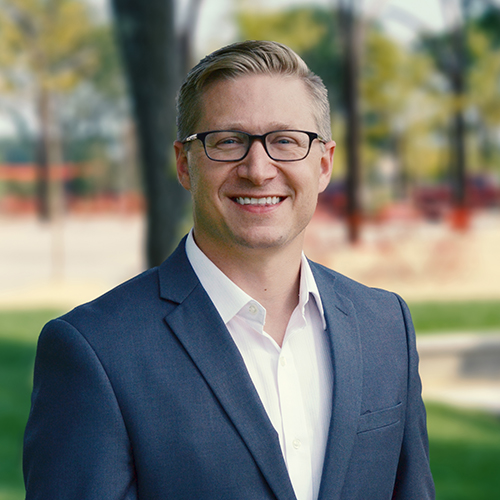Community Resilience Through Leadership and Governance: Planning for Complete Streets and Wetland Banking
 By Chris Silewski, PLA, and Greg Aldrian, PG
By Chris Silewski, PLA, and Greg Aldrian, PG
For a community to work toward a better future, local leaders must enable efforts that will lead to community resilience. Creating and implementing the right development policies and plans, such as those for resilient street design and wetland mitigation banking, will put things on the right track.
Resilient Street Design Through Complete Streets
A community’s network of streets comprises the largest square footage of any of its public spaces. This points to the importance of developing a community street design policy that will have beneficial impacts on a community’s resilience goals.
Historically, street design has been about transportation, with a heavy emphasis on efficiently moving motorized vehicles. This focus on vehicles has resulted in frequent (and sometimes tragic) conflicts between vehicles and pedestrians, as well as a loss of green spaces.
A more recent model for street design, called Complete Streets, shifts the focus to ensuring the safety and comfort of all who use the street, whether they are driving, walking, bicycling, scootering, riding public transit, or moving about with the aid of assistive devices. Complete Streets policies also prioritize preserving natural habitat and “rewilding” spaces by incorporating trees and vegetation in place of concrete and hardscape wherever it’s possible to do so without compromising safety.
A Complete Streets policy will ensure a community’s transportation planners and engineers consider the best interests of all residents in the use of local streets. Complete Streets policies will look different for each community, based on the local context. Elements of a Complete Streets design may include sidewalks, bike lanes, wide paved shoulders, special bus lanes, comfortable and accessible public transportation stops, frequent and safe crossing opportunities, median islands, accessible pedestrian signals, curb extensions, narrower travel lanes, roundabouts, and more.
Ayres professionals can work with communities seeking to ensure that resiliency is an outcome of future street design projects. By incorporating Complete Streets principles in policy that will guide such projects, communities stand to reap great benefits, including improved safety throughout the community; reduced traffic-related accidents; greater equity among all residents when it comes to the use of local streets; improved public health; and reduced transportation costs.
Wetland Mitigation Banking as a Financial Investment
Development within a community sometimes causes detrimental impacts on wetlands by altering topography and/or hydrology. In recent years, wetland mitigation banking has emerged as a favored instrument for replacing wetland and habitat function lost as the result of development activities, while allowing for economically beneficial community development projects to proceed.
While avoiding adverse impacts on wetlands is preferable from both ecological and economic resilience perspectives, the Ecological Restoration Business Association describes mitigation banks as “proven to deliver the highest quality, most reliable offset to environmental impacts … and a private investment into ‘green infrastructure’ to help offset the impacts associated with economic growth.”
While community investment in wetland mitigation banking can be economically advantageous, there are risks and uncertainties to be navigated. Those risks and uncertainties can be related to the possibility of regulatory changes by federal and state agencies, the availability of suitable land for development of the mitigation bank, and the viability of the plan to restore and maintain the mitigation bank over time ― to name a few.
Ayres professionals can help local leaders determine if investment in wetland mitigation banking is a viable option for their community, provide engineering and project management services to assist leaders through the steps of this highly regulated process, and keep all involved parties apprised of developments in the regulatory landscape. With the right expertise at the table, an investment in wetland mitigation banking can be the answer for a community striving for an environmentally and economically resilient future.

About the Expert:
Chris Silewski, PLA, brings creative and thoughtful input into the design process from conception to construction. Over the past 10+ years, he has focused on creating dynamic, place-specific designs that incorporate a sense of wonder. His innate interests in community outreach, local typology, art, ecology, and regional design make him a valuable resource to any project aimed at engaging the public in creating a place-specific destination.

About the Expert:
Gregory Aldrian, PG, who joined Ayres in September 2018, is an accomplished professional geologist and project manager with more than 28 years of experience in environmental, geotechnical, and construction project work. He has managed multidisciplinary teams on energy corridor projects, environmental pipeline inspections, spill response remediation, permitting, and wetland mitigation.
Chris Silewski, PLA, will share more information about developing Complete Streets policies and Greg Aldrian, PG, will share more information about investing in wetland mitigation banking during a free presentation on Nov. 16. The presentation is part of Ayres’ six-part webinar series, Reimagining Resilience. The recorded presentation also will be available online following Nov. 16. Visit Reimagining Resilience for more information.

Post a comment: